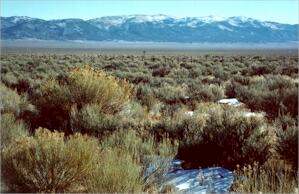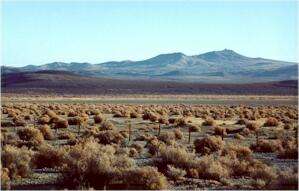GREAT
BASIN DESERT Overview The Great Basin Desert covers a large area of land bounded by the Sierra Nevada - Cascade mountain range to the west and the Rocky Mountain range to the east. Between these large mountain ranges are a series of valley floors (basins) with elevations of about 1200 metres (4000 foot). These basins are interspersed by smaller mountain ranges, running north to south, so the typical scenery in this desert region is of broad, flat plains or shallow slopes bounded by mountain ridges.
The valley floors have deep soils resulting from thousands of years of mountain erosion. But these valleys receive little rainfall; most of precipitation occurs as winter snow. The combination of hot, dry summers and cold winters results in a characteristic vegetation dominated by aromatic, perennial shrubs such as various forms of sagebrush (Artemisia species). This vegetation type is dominated by one species (big sagebrush) and is known as the Great Basin Sagebrush Zone. In the wetter, more northerly parts there is an increasing proportion of grasses, giving rise to a vegetation type termed Sagebrush Steppe. In other, scattered regions of this desert, where the soil particles are very fine, there are permanent lakes (e.g. the Great Salt Lake) or temporary lakes (called playas). These areas and the surrounding lands can have a high salt concentration caused by the evaporation of water. Such areas are dominated by various types of saltbush (Atriplex species) giving a vegetation type known as Salt-Desert Shrub.
Other plants and animals of the Great Basin Desert Compared with the other deserts of North America, the Great Basin Desert has a rather restricted range of plants and animals. For example, the only major cactus is the Plains pricklypear, a low-growing, spreading species (see Prickly pears). Apart from the sagebrush and saltbush species, other frequent shrubs include mormon tea (Ephedra species) and a range of small-leaved shrubs (greasewood, blackbrush, snakeweed, etc.). None of these plants is highly favoured by the larger grazing or browsing animals such as mule deer and pronghorn antelope. These animals do occur in the Great Basin Desert but prefer to eat grasses in the desert steppe regions. By selectively eating the grasses and smaller herbs, these animals (and grazing livestock) tend to increase the dominance of sagebrush. Ecological threats One of the major ecological threats to the sagebrush-dominated Great Basin ecosystem is the introduction and spread of alien invasive species. The most important of these is an annual grass, cheatgrass brome (Bromus tectorum) which was introduced in the late 1800s and early 1900s from Eurasia and the Mediterranean region - probably as a contaminant in imported seed. This plant now dominates large areas of sagebrush steppe and is highly valued by ranchers because it provides the main source of spring forage for livestock. However, it has largely replaced a range of native perennial grass species and, equally important, the large amount of dry herbage that it produces at the end of its short growing cycle leads to severe fire risk. In many areas the incidence of intense wildfires has increased from once every 60-100 years to once every 3-5 years. The intense heat destroys sagebrush and the native perennial grasses, and often prevents sagebrush from re-establishing, because it does not regenerate quickly after fires. In contrast, cheatgrass brome produces abundant seeds each year and rapidly re-establishes after fires, from its seedbank in the soil. Click HERE (not on this server) for a full account of this plant, its ecological impact and the potential measures for controlling it. |
||||


